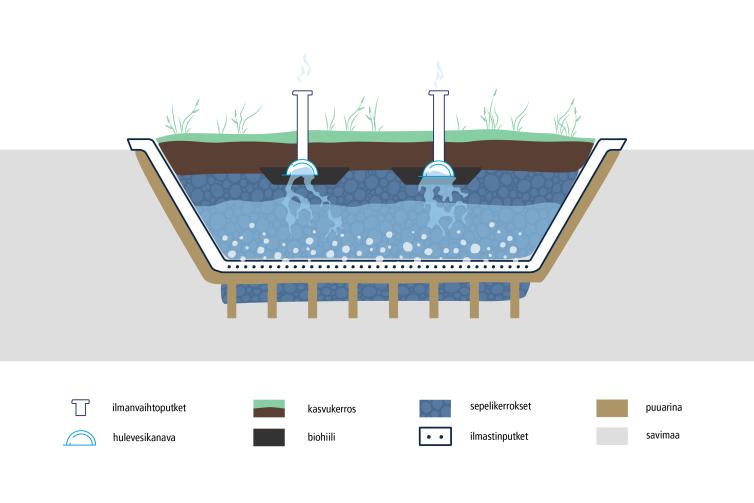Finavia’s underground wetland is the first of its kind in the Nordic countries.
“The completion of the underground wetland is a significant investment in improving the quality of bodies of water in the surrounding areas and managing the quality of stormwater. We use it to reduce the load on bodies of water and the erosion of streambeds caused by aircraft deicing and runway anti-skid agents,” says Tuija Hänninen, Finavia’s Environmental Specialist.
The underground wetland filters water through gravel and the biofilm that grows on the gravel. Compressed air pumped to the bottom of the wetland increases the efficiency of microbial decomposition.
Image: The wetland is a basin filled with gravel and sealed at the bottom, where the stormwater that drains onto its surface is treated when it passes through the gravel layer. The wetland consists of a stormwater aeration cell (surface area 600 m2) and a storage cell (surface area 2,000 m2). In the aeration cell, the treatment is enhanced by the compressed air supplied from the bottom of the basin through the aeration system.
Finavia will monitor the operation of the wetland for the next two years in accordance with a precise measurement programme.
“The operation of the wetland was studied by a pilot-scale unit at Aalto University. If the wetland functions as expected and improves the quality of the stormwater passing through it, similar wetlands could also be built for the draining of other waters.”
Improvements to water management also at other Finavia airports
Water management is a significant part of Finavia’s environmental work. In recent years, Finavia has also made improvements to glycol collection at airports such as Turku and Tampere airports.
“In winter, water containing propylene glycol is collected at airports using vacuum trucks and delivered for treatment. The snow is piled in separately built snow areas, from where meltwater is directed to further treatment. This reduces the load of propylene glycol mixed with snow on bodies of water. Aircraft deicing agent is not classified as toxic, but it consumes oxygen and causes odour when broken down in natural waters.”
Improvements are also planned for Lapland’s airports.
“We have built a similar snow area at Ivalo Airport, where glycol-containing snow is collected in winter in order to be directed to further treatment. A new glycol water basin is also being planned at, for example, Kittilä Airport, which will make the collection of glycol-containing water more efficient and enable regulated delivery to a wastewater treatment plant or for other treatment.”
Most of the glycol collected by Finavia is made use of at, for example, wastewater treatment plants, where it can be used as a carbon source in the nitrogen removal process and in digestion tanks for the production of methane.
Further reading
An underground wetland improves the condition of streams and bodies of water near Helsinki Airport




